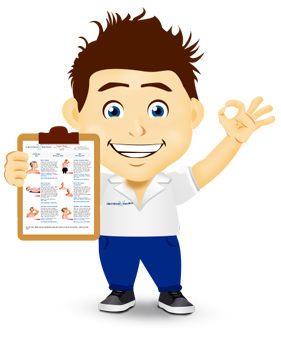
Next steps:
Feel free to read the advice sheet below! To get the full benefit click on 'Start treatment'. By starting the treatment you will get access to weekly rehab programmes online for FREE. You will be able to track your progress, pain levels and we will remind you to do your exercises every day!
Acute back pain is common, and usually not serious. Acute back pain usually involves muscle spasm, inflammation along the facet joints, and can be related to disc problems.
So what exactly happens? Well there are a few processes going on that need to be discussed.
Firstly acute back pain can occur when either bending forwards, or bending backwards, or coming up from a forward bend. For example, imagine you are picking up a pen from the floor, you bend forwards, and then something “goes” in your back. Your back is in spasm and you are feeling very sharp pain. This is an acute back pain. The pain is typically so severe you cannot sit comfortably, or stand for long periods, and typically the only comfortable place is the bed.
But why does it occur? This is often a combination of weak core muscles, stiff or hyper-flexible (hypermobile) spine, or poor posture.
Lower Back Anatomy

Facet joints are nestled in the back on either side of your spinal column between the vertebral bodies and the discs. Each vertebra has a bony prominence on either side forming a facet joint between the vertebra above and below. Facet joints are surrounded within a joint capsule and it has been shown that within the lower back a meniscoid structure can lie, similar to that of a mini version of the knee joints’ meniscus. The main role of the facet joint is to minimize excessive movement and provide the spine with stability.
In-between the vertebrae sit discs – these help the vertebrae to absorb force and to allow movement. Surrounding the vertebrae are muscles, ligaments and nerves. All of which can become injured and thus increasing the severity of the acute back pain.
How to treat Acute Back Pain
- Anti-Inflammatory Medication
In severe cases, a non-steroidal anti-inflammatory can help for a short period of time. Inflammation and pain will be reduced, which will allow you to move freely and not have to worry about being in a tremendous amount of pain. Get advice from your doctor on when/how to take this.
- Physical Therapy, Osteopathy, Chiropractic
See your therapist as soon as possible. Typically the problem can be treated very quickly. Expect to need treatment every 2-3 days and depending on the severity of the joint pain, back pain can be significantly improved in just a few days compared to rest at home. If the problem has lasted longer than a week and you have limited movement, a therapist might be able to manipulate the joints using a controlled thrust. This will work to open up the joint and break down any scar tissue in the early stages, which can limit your range of movement. Thrusts are not always required, and gentler mobilizations can be very effective. Heat treatment and massage usually precede the treatment to help relax any spasms. Ultrasound or other forms of electrotherapy such as TENS or interferential can also help reduce inflammation.
- Exercises
Your Rehab My Patient therapist will discuss exercises that you can do to improve mobility to your spine, which will reduce inflammation and muscle spasm.

Tips:
- Prolonged inactivity does not tend to help - stay active and mobile.
- Do everything you can to take care of your back when lifting or loading your spine.
- Perform exercises to help strengthen your spine and stabilise the surrounding muscles.
- Using ice and/or heat can help reduce pain. Be careful with ice or heat burns, so always use a towel and don't apply directly to the skin.

